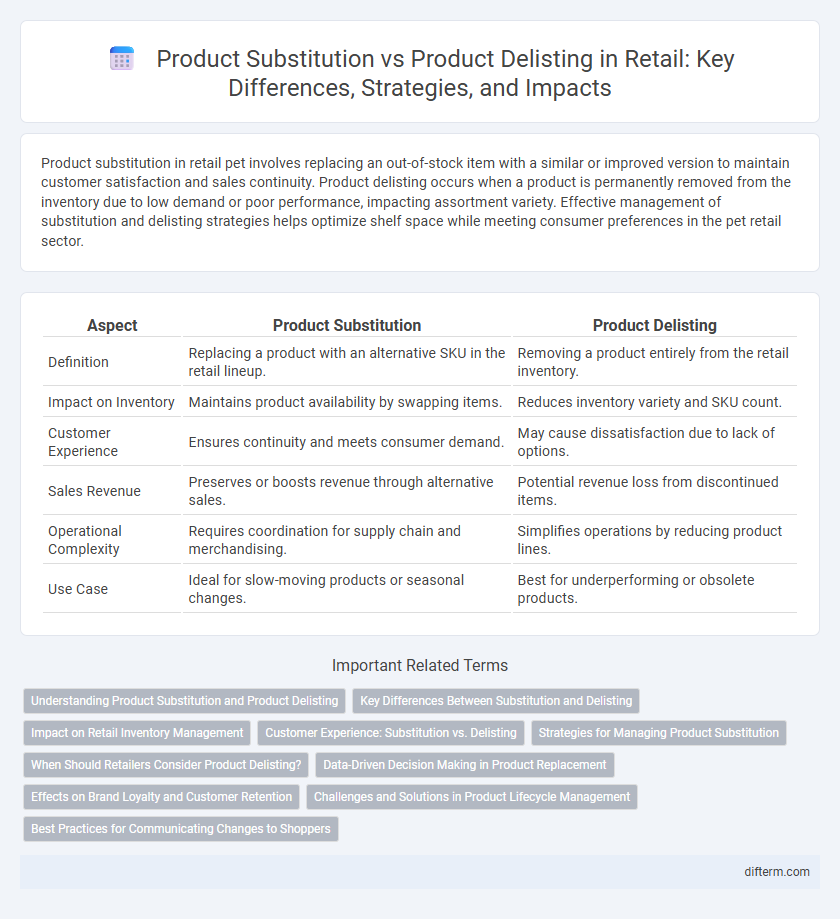Product substitution in retail pet involves replacing an out-of-stock item with a similar or improved version to maintain customer satisfaction and sales continuity. Product delisting occurs when a product is permanently removed from the inventory due to low demand or poor performance, impacting assortment variety. Effective management of substitution and delisting strategies helps optimize shelf space while meeting consumer preferences in the pet retail sector.
Table of Comparison
| Aspect | Product Substitution | Product Delisting |
|---|---|---|
| Definition | Replacing a product with an alternative SKU in the retail lineup. | Removing a product entirely from the retail inventory. |
| Impact on Inventory | Maintains product availability by swapping items. | Reduces inventory variety and SKU count. |
| Customer Experience | Ensures continuity and meets consumer demand. | May cause dissatisfaction due to lack of options. |
| Sales Revenue | Preserves or boosts revenue through alternative sales. | Potential revenue loss from discontinued items. |
| Operational Complexity | Requires coordination for supply chain and merchandising. | Simplifies operations by reducing product lines. |
| Use Case | Ideal for slow-moving products or seasonal changes. | Best for underperforming or obsolete products. |
Understanding Product Substitution and Product Delisting
Product substitution in retail involves replacing an out-of-stock item with a similar alternative to maintain sales continuity and enhance customer satisfaction. Product delisting refers to permanently removing a product from the inventory due to low demand, poor performance, or strategic business decisions. Effectively managing substitution and delisting impacts inventory optimization, customer retention, and overall profitability.
Key Differences Between Substitution and Delisting
Product substitution involves replacing an existing product with a similar alternative to maintain customer choice and sales continuity, whereas product delisting refers to the complete removal of a product from the retail assortment. Substitution aims to manage inventory shortages or supplier issues without losing market share, while delisting is often driven by low demand, poor sales performance, or strategic category changes. Retailers leverage substitution to minimize stockouts and preserve brand loyalty, but delisting helps optimize shelf space and focus on high-performing SKUs.
Impact on Retail Inventory Management
Product substitution in retail inventory management allows for maintaining sales continuity by replacing out-of-stock items with similar alternatives, minimizing lost revenue and customer dissatisfaction. Product delisting removes items permanently from the inventory, streamlining stock but potentially reducing product variety and impacting customer retention. Efficient inventory systems must balance substitution strategies with delisting decisions to optimize stock levels, reduce carrying costs, and enhance overall supply chain responsiveness.
Customer Experience: Substitution vs. Delisting
Product substitution enhances customer experience by providing alternatives when a preferred product is unavailable, maintaining satisfaction and minimizing purchase disruption. In contrast, product delisting can lead to frustration and loss of loyalty if customers cannot find suitable alternatives, negatively impacting brand perception. Retailers optimizing substitution strategies with relevant, high-quality replacements typically achieve higher retention and improved customer engagement.
Strategies for Managing Product Substitution
Effective strategies for managing product substitution in retail include analyzing consumer preferences, inventory levels, and sales data to identify suitable alternative products that meet customer needs. Utilizing predictive analytics and AI-driven recommendations enhances the accuracy of substitutions, driving customer satisfaction and minimizing lost sales. Collaborating with suppliers to maintain flexibility in product assortments ensures seamless transitions and supports overall inventory optimization.
When Should Retailers Consider Product Delisting?
Retailers should consider product delisting when sales consistently underperform despite promotional efforts and when inventory turnover rates decline below industry benchmarks, indicating diminished consumer demand. Delisting assists in optimizing shelf space for higher-margin or trending products, thereby improving overall category profitability and customer satisfaction. Data-driven analysis of sales velocity, customer feedback, and market trends is critical to making informed delisting decisions.
Data-Driven Decision Making in Product Replacement
Data-driven decision making in retail product replacement leverages sales analytics, customer preferences, and inventory turnover to determine whether product substitution or delisting maximizes profitability. Advanced machine learning models analyze historical transaction data and market trends to predict the potential success of substituting a product versus removing it entirely. Retailers using predictive analytics can optimize their product mix, reduce stockouts, and enhance customer satisfaction by aligning replacement strategies with real-time demand signals.
Effects on Brand Loyalty and Customer Retention
Product substitution can maintain brand loyalty by offering customers alternative options within the same brand, minimizing disruption in purchasing behavior and preserving trust. In contrast, product delisting risks eroding customer retention as the brand removes familiar choices, potentially driving consumers towards competitors. Effective communication and strategic substitution are critical to sustaining customer engagement and long-term loyalty in retail markets.
Challenges and Solutions in Product Lifecycle Management
Product substitution challenges in retail include maintaining inventory balance and customer satisfaction when replacing discontinued items, while product delisting risks losing loyal customers and complicates demand forecasting. Solutions involve advanced data analytics and AI-driven demand prediction to optimize product lifecycle management and ensure seamless transitions in inventory assortments. Integrating real-time sales data with supplier communication platforms enhances decision-making for timely substitutions or delistings, minimizing revenue loss.
Best Practices for Communicating Changes to Shoppers
Effective communication of product substitution and delisting in retail involves clear, timely notifications that highlight alternatives while explaining reasons for changes. Using multi-channel strategies such as in-store signage, email alerts, and mobile app notifications ensures shoppers receive consistent information and maintain trust. Transparency about product availability and benefits of substitutes enhances customer satisfaction and reduces purchase disruption.
product substitution vs product delisting Infographic

 difterm.com
difterm.com